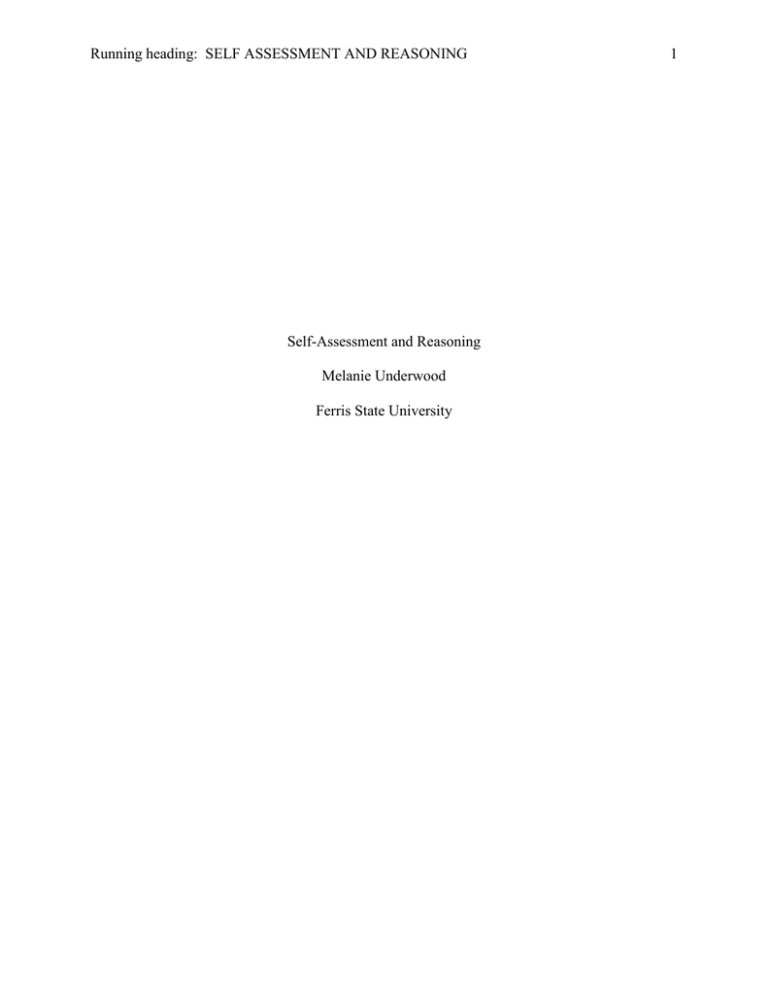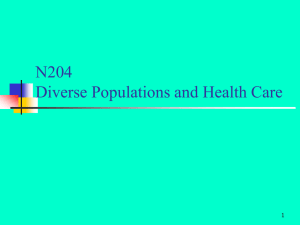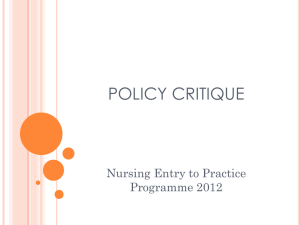Self Assessment and Reasoning - Melanie Underwood RN
advertisement

Running heading: SELF ASSESSMENT AND REASONING Self-Assessment and Reasoning Melanie Underwood Ferris State University 1 Running heading: SELF ASSESSMENT AND REASONING 2 Self-Assessment and Reasoning Significant Content Health promotion in vulnerable populations is of significant importance, because it is something that we see every day. The values, attitudes, culture and life circumstances of individuals who are poor, socially marginal, or culturally different from the traditional mainstream of society, and the communities in which they reside, must be recognized when planning health promotion and prevention activities. Vulnerable populations affect many individuals in a variety of ways. Vulnerable populations may include people of color, the poor, non-English-speaking persons, recent immigrants and refugees, homeless persons, mentally ill and disabled persons, gay men and lesbians, and substance abusers (Pender, 2011). Promoting and achieving health equity would mean that everyone has the opportunity to attain their full health potential, therefore no one has any disadvantages from attaining their potential based on social, demographic, or geographic differences (Pender, 2011). Thoughts and Feelings We as health care professionals should be personally aware of their cultural values and beliefs and also be able to recognize how these belief and attitudes will affect the groups they come into contact with (Pender, 2011). Cultural competence is defined “as appropriate and effective communication that requires one to be willing to listen and learn from members of diverse populations and the provision of information and services in appropriate languages, at appropriate comprehension and literacy levels, and in the context of the individual’s health belief and practices” (Pender, 2011). Since the early days of nursing “cultural care” was a term used by one of the great theorists Madeleine Leininger and her personal experience of caring for Running heading: SELF ASSESSMENT AND REASONING 3 children of different cultures and their families. Nurses who follow Leininger’s theory of cultural care in their practice view patients in the context of their individual cultures (Chitty, 2011). Leininger recognized that cultural knowledge is necessary to understand the difference needed to facilitate cooperativeness and healing. This awareness motivated Leininger to develop a new nursing theory; call Trans-cultural nursing is learning and understanding different cultures in order to provide better patient care (Phillips, Ray, Underwood, 2012). After an initial assessment, the nurse should create a care plan that considers the patient’s cultural variations, understanding of health, illness, beliefs, and practices (“The Basic concepts”, 2012). Our health care environment is made up of several different cultures and beliefs; with this we as nurses need to adapt in order to provide the best care possible for our patients. Point of View or Assumptions Prior to this assignment I feel as if my knowledge of vulnerable populations was vague. I didn’t necessarily have an understanding of vulnerable groups of patients I just gave 100% and tried to adapt to meet their needs, without really having an understanding of what was different. But after class reading, participation with group discussion, and further research I have a greater understanding and respect of what vulnerable population means to me. It would include different cultural beliefs, religions, socioeconomic status, diseases processes, illness, children, and the elderly, just to name a few that I interact with every day. I also have a better understanding on how this had been tied into nursing theory many years ago by Madeleine Leininger and her theory on Trans-Cultural nursing. Our society is not a one size fits all we must tailor our care to meet each patient’s individual needs, and if I am are not sure what those specific needs may be I will personally find out what they are. This is a nursing career Running heading: SELF ASSESSMENT AND REASONING 4 commitment to continue to learn from those around me because for me knowledge is power and the key to success. Analysis of Thinking To analyze my topic I had to think of an area that we studied this semester that really had an impact on my critical thinking and how I would use this information to enhance my current practice. I look through numerous discussion boards and the one that had the most impact would be that of vulnerable populations. This was influenced by my lack of understanding and importance of vulnerable populations and the need to learn more. Again Trans-cultural nursing theory played a large part to help with the understanding and the implementation into my current practice. In grading myself I think initially I would have given myself a D but after great strides and a better understanding of vulnerable populations I would currently give myself a B in that I have made vast improvement of my knowledge and understanding but, there is always room to grow. This improvement was also made possible by critical thinking skills learned during this semester. Therefore I can say that I personally relate to the definitions of critical thinking presented by Paul and Elder’s stating “Critical thinking is a process by which the thinker improves the quality of his or her thinking by skillfully taking charge of the structures inherent in thinking and imposing intellectual standards upon them” (Chitty, 2011). Which also goes on to state that a “well-cultivated critical thinker” does the following: Raises questions and problem and formulates them clearly and precisely. Is open-minded and recognizes alternative ways of seeing problems and has the ability to assess the assumptions, implications, and consequences of alternative views of problems (Chitty, 2011). These are just two areas that I felt affected me, shown by what I have learned this semester so far. Raising questions and problems as they relate to cultural diversity, and how little we really know about different cultures and how different Running heading: SELF ASSESSMENT AND REASONING 5 beliefs directly affect the patients we care for. Making it a life-long commitment to learning and growing together in the nurse patient relationship. References Chitty, K.K., & Black, B.P. (2011). Professional nursing: Concepts and challenges (6th ed.) Maryland Heights, MO: Saunders Pender, N. J., Murdaugh, C. L. & Parsons, M. A. (2011). Health Promotion in Nursing Practice (6th ed.). Upper Saddle River, NJ: Prentice-Hall. Phillips, L., & Ray, V., Underwood, M. (2012). Madeleine Leininger and Transcultural Nursing Theory. "The Basic Concepts of Transcultural Nursing" (2012), Transcultural Nursing, http://www.culturediversity.org/basic.htm




